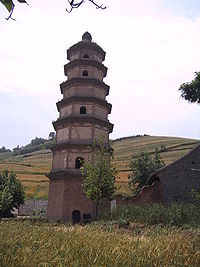- Daqin Pagoda
-
Daqin Pagoda (大秦塔, "The Roman Tower") in Chang'an, Shaanxi Province, located about two kilometres to the west of Louguantai temple,[1] is the remnant of the earliest surviving Christian church in China. The church and the monastery were built in 640 by early Nestorian missionaries. Daqin is the name for the Roman Empire in the early Chinese language documents of the 1st and 2nd centuries,[2] by the mid-9th century it was also used to refer to the mission churches of the Syriac Christians.[3]
Contents
History
Persecution of Christians in China led to the abandonment of Daqin in about 845.[3] By the Northern Song Dynasty at the latest, a Buddhist temple was installed in the pagoda. The great poet Su Shi visited the place in 1064 and wrote a well-known poem about it, the poem entitled "Daqin Temple". His younger brother Su Zhe also wrote an "echoing" poem referring to the monks at the temple. An earthquake severely damaged the pagoda in 1556 and it was finally abandoned. Due to the earthquake, many of the underground chambers of the complex are no longer reachable. Daqin was "rediscovered" in 1998[1] and its roots in early Chinese Christianity were recognized,[clarification needed][citation needed] but controversy remains as scholars, like Jonathan Chaves of the George Washington University, criticized the lack of details and pointed out that the seriously damaged sculptures are entirely consistent with known Buddhist iconographical schemes instead of Christian ones.[citation needed]
The pagoda today
Inside the pagoda, artistic works in both Western and Asiatic style can still be found[citation needed], among them Jonah at the walls of Nineveh, a nativity scene (depiction of the birth of Jesus) and Syriac graffiti. Many of these artworks are made from mud and plaster, which suffered during prior centuries from exposure to the elements. Seismic activity and flooding endanger the stability of the pagoda. In 1999, the pagoda's exterior was restored, but overall stability was not improved. Further restoration of the site is planned, as well as exploration, most probably by remote probe, of the collapsed underground chambers.[4]
Outside of the pagoda, a replica of the Nestorian Stele and its stone tortoise have been installed.
The exterior of the pagoda and its surroundings were featured in the first episode of the 2009 BBC program "A History of Christianity".[5] The program also features an interview with Martin Palmer by the presenter Professor Diarmaid MacCulloch.
See also
References
- ^ a b Martin Palmer, The Jesus Sutras: Rediscovering the Lost Religion of Taoist Christianity, ISBN 0749922508, 2001
- ^ Hill, John E. (2003). "The Kingdom of Da Quin". The Western Regions according to the Hou Hanshu (2nd ed.). http://depts.washington.edu/silkroad/texts/hhshu/hou_han_shu.html#sec11. Retrieved 2008-11-30.
- ^ a b Jenkins, Philip (2008). The Lost History of Christianity: the Thousand-Year Golden Age of the Church in the Middle East, Africa, and Asia - and How It Died. New York: Harper Collins. pp. 64–68. ISBN 978-06-147280-0.
- ^ Thompson, Glen L (April 2007). "Christ on the Silk Road: The Evidences of Nestorian Christianity in Ancient China". Touchstone Journal. http://touchstonemag.com/archives/article.php?id=20-03-030-f. Retrieved 2008-11-30.
- ^ http://www.bbc.co.uk/programmes/b00ntrqh
External links
- Did Christianity Reach China In the First Century?
- Site from China about location
- Orthodox article on site
Syriac Christianity Churches (West Syrian) Churches (East Syrian) Historically: Church of the East - Related: Nestorianism
Presently: Ancient Church of the East · Assyrian Church of the East · Chaldean Catholic ChurchChurches (in India) Historically: Malankara Church
Presently:
Eastern Oriental: Chaldean Syrian Church (Assyrian Church of the East in India)
Orthodox: Jacobite Syrian Christian Church · Malankara Orthodox Syrian Church (Indian Orthodox Church)
Catholic: Syro-Malabar Catholic Church · Syro-Malankara Catholic Church
Reform: Malabar Independent Syrian Church · Malankara Mar Thoma Syrian Church · St. Thomas Evangelical ChurchLanguages Assyrian Neo-Aramaic · Bohtan Neo-Aramaic · Chaldean Neo-Aramaic · Garshuni · Hértevin · Koy Sanjaq Surat · Syriac · Mlahsô · Senaya · TuroyoNational identity Shaanxi topics General Geography Education Cuisine Biángbiáng noodlesVisitor attractions Qinqiang opera • Daqin Pagoda • Banpo Neolithic village • Zhao Mausoleum • Mount Hua • Mausoleum and Terracotta Army Museum • Bell Tower and Drum Tower • Forest of Stone Steles Museum • Shaanxi History MuseumCategories:- Buildings and structures in Shaanxi
- Chinese pagodas
- Nestorianism in China
- Tang Dynasty art
- 7th-century church buildings
Wikimedia Foundation. 2010.

